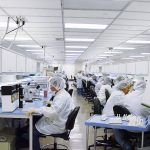 Electronics manufacturers have a few things to consider when determining how to best clean electronics. These include the cleaning solvent, equipment, and whether to use a wet or dry process. Here is a short breakdown of these considerations.
Electronics manufacturers have a few things to consider when determining how to best clean electronics. These include the cleaning solvent, equipment, and whether to use a wet or dry process. Here is a short breakdown of these considerations.
Cleaning agents
The right cleaning agent depends on what you’re removing and what it’s stuck to. Doris Schulz of Controlled Environments describes in “Cleaning in Electronics Manufacturing” the kinds of cleaning agents used in this industry. “Cleaning agents currently used in electronics manufacturing include solvents, water-based media containing alkaline surfactants, and water-based tenside-free cleaning agents.”
She also explains that solvents contain modified alcohols, non-halogenated hydrocarbons, or hydrofluorethers (HFEs).
Monosolvent systems usually use an azeotrope or pure HFE to remove:
- Particles
- Halogen compounds
- Dust
- Light oils
- Residue of easy clean solvent
- Other slight impurities
Cosolvent systems combine an HFE with a low-volatility organic solvent. Bisolvent systems are similar but the solvent and rinsing agent are kept separate whereas they are mixed together in a cosolvent. These best remove:
- Grease
- Heavy oils
- Adhesives
- Waxes
- NC-flux residues
- Hot-melt glues
- Other more stubborn impurities
Wet Cleaning Systems
When choosing your system, Shulz advises to answer the following questions: “What throughput must be handled? What space is available in which to set up the equipment? How can the cleaning process be integrated into the manufacturing chain?”
Think about these questions when you choose from the many available cleaning systems. The variety of systems exists because the variety of plants demands it. Systems range from spray cleaning to pressure flooding to ultrasound. Choose what makes the most sense in your space and within your technology.
What makes ultrasound technology a popular choice for cleaning is the varying frequencies that can be applied. This one method can be used for many applications. Even experts who restore fire-damaged electronics can use ultrasound to get equipment clean and working again. The lower the frequency, the more energy is released. Ask your equipment or cleaning agent supplier about the right frequency for your needs.
Dry Cleaning Systems
There are some alternatives to the wet systems, and they mainly include CO2 and plasma.
Compressed carbon dioxide – This works very well to access crevices, small holes, and the like. It is dry, residue-free, and environmentally-friendly. Shulz explains: “In electronics manufacturing this technology offers the ability to clean such items as complete PCBs and assemblies, removing flux residues and cleaning away oils and grease from metallic components such as contacts.”
CO2 Snow jet cleaning – These minute snow crystals have chemical, thermal, and mechanical properties. This dry process is non-poisonous and non-inflammable. Shulz says, “CO2 snow removes surface films and particulate contamination leaving no residue, and can also be used selectively on functional areas such as contact points.”
Plasma – The physical and chemical reaction of this procedure offers both a surface treatment for multiple components and electronic parts and also effective cleaning of organic impurities. Depending on your needs, you can either choose a low-pressure plasma or inline-capable atmospheric pressure plasma.
While no-clean fluxes and soldering plates have changed the electronics manufacturing industry, cleaning has not become obsolete. If these no-clean components are exposed to humidity or fluctuation temperatures, they gradually erode. Furthermore, many processes and components demand a high level of surface cleanliness. Compare your needs against the capabilities of the cleansing agents and systems to find the best fit for you.
Gerbig Engineering Company builds high-quality cleanrooms. We also perform certification and validation. For questions about your cleanroom needs, contact us at 888-628-0056 or info@gerbig.com